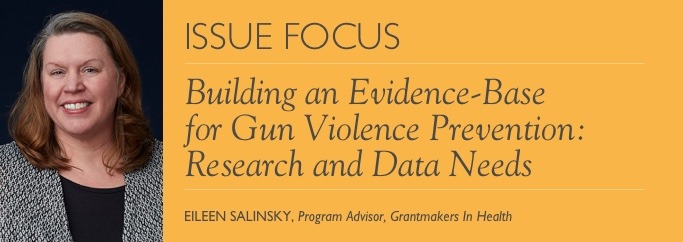September 2019

Gun violence prevention research is woefully underfunded, receiving significantly less research funding and scientific attention compared with other leading causes of death. Using a methodology that calculated expected levels of research investment based on mortality rates, one study estimated that between 2004 and 2015 gun violence received just 1.6 percent of the federal research support projected ($1.4 billion predicted, $22 million observed) and had 4.5 percent of the volume of publications anticipated (38,897 publications predicted, 1,738 observed) (Stark and Shah 2017).
Federal Research Restrictions
Low levels of federal investment in gun violence research have been widely attributed to the Dickey amendment, a provision included annually in congressional appropriations legislation since 1996 that bars the Centers for Disease Control and Prevention (CDC) from using funds to advocate for or promote gun control (Rostron 2018). In 2011, the prohibition was extended to include the National Institutes of Health. The Dickey amendment does not explicitly ban gun violence research. However, funding cuts made when the amendment was first enacted essentially eliminated CDC support for such work and signaled opposition to agency research efforts that could be interpreted as supporting gun control policies.
Recent legislative activity suggests increasing receptivity to federal support for gun violence research, but funding has not yet been restored. Fiscal year 2018 appropriations language clarified that CDC has the authority to conduct research on the causes of gun violence, but dedicated funds were not provided for that purpose. On June 19, 2019, the House passed an appropriations bill (H.R. 2740) that earmarks $50 million to study prevention of firearm deaths and injury, while also retaining the Dickey amendment prohibition on gun control advocacy. As the bill awaits consideration by the Senate, it remains unclear if these dedicated funds will be included in the final fiscal year 2020 appropriations package.
Status of the Evidence Base
Failure to invest in rigorous research over the last two decades has resulted in a dearth of knowledge to inform gun violence prevention policy and programs. A 2013 report from the Institute of Medicine concluded that “the scarcity of research on firearm-related violence limits policymakers’ ability to propose evidence-based policies that reduce injuries and deaths and maximize safety” (IOM and NRC 2013). The RAND Corporation recently conducted a comprehensive synthesis of the scientific evidence regarding the effects of 13 types of gun safety policies and found that, with a few exceptions, the evidence base to support policy decisions is inadequate. (Morral et al. 2018)
Evidence-based Gun Safety PoliciesDespite significant gaps in the evidence base, scientific support does exist for a number of gun safety policies. RAND’s 2018 synthesis found that “[a]vailable evidence supports the conclusion that child-access prevention laws, or safe storage laws, reduce self-inflicted fatal or nonfatal firearm injuries among youth…[and also] reduce unintentional firearm injuries or unintentional firearm deaths among children.” The study also found:
|
Priorities for Future Research
Because federal investments to date have been inadequate, there are numerous data collection and research needs related to gun violence prevention. Even basic descriptive data on gun possession, distribution, acquisition, storage practices, and injuries are lacking. Experts have recommended a variety of improvements to existing data systems to address these deficiencies, including: enhancing the Behavioral Risk Factor Survey System to provide for state-level estimates of gun ownership, expanding the National Electronic Injury Surveillance System to monitor non-fatal gun injuries at the state level, removing research restrictions imposed on gun trace data collected by the Bureau of Alcohol, Tobacco, and Firearms to assess the source of guns used in crimes, and revising and expanding the National Crime Victims Survey to yield state-level estimates of crime victimization. Some have called for the creation of a national registry of firearm violence to include data on both fatal and nonfatal firearm injuries.
In addition to necessary investments in the federal data infrastructure, increased funding for research from public or private sources is also needed to support high-quality, methodologically rigorous studies and expand the pool of researchers with relevant expertise. Priorities for applied research include both policy research to assess the impact of a wide variety of gun safety laws and evaluations to examine the effectiveness of promising programmatic interventions, such as hospital-based violence intervention and group violence intervention. Crafting more effective interventions also depends on developing a better understanding of the nature, causes, and consequences of gun violence. Different types of gun violence, including suicides, unintentional injuries and fatalities, and homicides and non-fatal assaults, are associated with different risk and protective factors. More research is needed in all of these areas to characterize how and why guns are acquired and used by various populations under varying circumstances.
The Role of Private Funders
Although private philanthropy cannot hope to substitute for government funding, a number of private funders have taken strategic steps to support gun violence research in the absence of federal leadership and have made critical contributions to the existing evidence base.
The Joyce Foundation has been a major funder of gun violence prevention research over the last 25 years. Since 1993 the foundation has invested $32 million through 141 grants to support gun violence research, capacity building, or dissemination. A recent report provides a comprehensive review of the foundation’s grantmaking related to gun violence research and summarizes key research findings resulting from these investments. The foundation’s efforts have focused on six major research areas:
- reframing gun violence as a public health issue;
- assessing gun availability as a risk factor for gun violence;
- understanding gun-related behaviors (such as gun ownership and storage, legal public carry of firearms, and self-defensive gun use);
- characterizing gun crimes;
- evaluating gun violence prevention policies and practices; and
- building research capacity (such as supporting the development, expansion, and improvement of the National Violent Death Reporting System and helping the scientific community establish research agendas for gun violence prevention).
The National Collaborative on Gun Violence Research (NCGVR), seeded with a $20 million gift from Arnold Ventures, is supporting carefully selected, rigorous research designed to broaden agreement on the facts associated with gun policy and inform the development of fair and effective policies. The initiative announced 17 awards for research studies in July 2019, totaling nearly $10 million in funding. The research will focus on a variety of topics including suicide, school violence, officer-involved shootings, and firearm safety.
The Fund for a Safer Future, a multi-funder collaborative, is currently funding several studies that seek to evaluate the impact of gun policies. These efforts include research to assess the effects of California’s Gun Violence Restraining Order law, a study to explore the relationship between violent crime and laws that allow civilians to carry loaded, concealed handguns in public spaces without obtaining a permit, and research on the comparative effectiveness of different minimum age requirements for firearm purchases by adults with juvenile criminal records. The Fund is also supporting a large-scale analysis of firearm transaction records to identify distinct and predictive purchasing patterns associated with the risk of future firearm violence, as well as a nationally representative survey of US adults who live in homes with firearms and a random sample of their adolescent children.
The Robert Wood Johnson Foundation funded the development of the state firearm laws database which provides a longitudinal perspective on the evolution of state laws from 1991 to present. Building on this work, the foundation is currently funding the Boston University School of Public Health to explore the attitudes and values of gun owners in order to develop message framing strategies that resonate with these groups.
The California Wellness Foundation has a long history of supporting gun violence prevention and has funded research activities along with policy advocacy efforts. Funded research has focused on illuminating the factors that contribute to the gun violence epidemic and identifying solutions that will curb gun violence and reduce the threat. For example, over the past several years the foundation has awarded $650,000 to the Violence Prevention Research Program at the University of California Davis and over $500,000 to the Violence Policy Center.
Kaiser Permanente has launched a Task Force on Firearm Injury Prevention and has committed $2 million for research to prevent gun injuries and death. In June 2019, Kaiser Permanente announced funding for three research studies that will focus on how clinicians can help prevent firearm injuries. Recognizing that health systems have an important role to play in gun violence prevention, the studies are intended to inform the development of clinical-level interventions related to safe weapon storage, suicide prevention, and risk prediction.
Missouri Foundation for Health has identified three overarching goals for its gun violence prevention efforts: strengthening the St. Louis-based network working to address interpersonal gun violence; supporting the testing and spreading of promising and effective solutions to address gun violence across the state; and advancing a more nuanced and shared understanding of the impact of gun violence on Missouri communities. In addition to supporting several community-based approaches to gun violence prevention, the foundation has also funded research examining how to depolarize the issue in order to more effectively frame conversations about gun-involved accidents, suicides, and intentional harms, and the steps that can be taken to prevent them. Building on this foundational work, the foundation reaffirmed its commitment to gun violence prevention this summer and plans to develop a comprehensive, state-based research approach by early next year.
Although many of the efforts described above represent significant philanthropic investments, health funders with more limited budgets, particularly those focused at the local level, can make important contributions to gun violence prevention research. For example, funders can study how gun violence is experienced and addressed within their own communities and can assess how existing gun safety laws are being implemented within local jurisdictions. The number of experts with relevant subject matter and methodological expertise is small, but these researchers are eager to build the field and are often willing to provide guidance to local academic institutions and law enforcement agencies. Adequate resources should always be made available to conduct rigorous evaluations.
Relatively few health funders currently support gun violence prevention research, but many are beginning to explore ways to engage in this important issue. Strengthening the evidence base on gun violence prevention is a familiar strategy for health funders who typically rely on objective analyses to both guide investments in public health and build momentum for broader community action. Providing research funding is a natural first step for funders seeking to expand their role in gun violence prevention.
References
IOM, and NRC. 2013. Priorities for Research to Reduce the Threat of Firearm-related Violence. Washington, DC.
Morral, Andrew R., Rajeev Ramchand, Rosanna Smart, Carole Roan Gresenz, Samantha Cherney, Nancy Nicosia, Carter C. Price, Stephanie Brooks Holliday, Elizabeth L. Petrun Sayers, Terry L. Schell, Eric Apaydin, Joshua Lawrence Traub, Lea Xenakis, John Speed Meyers, Rouslan I. Karimov, Brett Ewing, and Beth Ann Griffin. 2018. The Science of Gun Policy: A Critical Synthesis of Research Evidence on the Effects of Gun Policies in the United States. Santa Monica, CA: RAND Corporation.
Rostron, A. 2018. The Dickey Amendment on Federal Funding for Research on Gun Violence: A Legal Dissection. Am J Public Health 108 (7):865-867.
Stark, D. E., and N. H. Shah. 2017. Research on Gun Violence vs Other Causes of Death. JAMA 317 (13):1379.
Focus Areas:
Topics:
